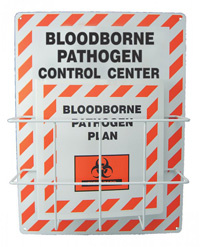



Find all of your laboratory and workplace safety supplies at Safety Emporium!
 Hypertension |
 Glossary Index |
 Hypoxia |
| MSDS Topics |
Free Sites | FAQ's | Regulations | Glossary | Software | Suppliers |
| Books | Forum | Poll | Fun stuff | Quiz | Store | |
| Understand your MSDS with the MS-Demystifier | Search ALL our MSDS info | |||||

Safety Emporium carries bloodborne pathogen compliance centers and related compliance materials.
Hypoglycemia can be a dangerous condition because glucose is the major source of energy for the brain. Lack of glucose, like lack of oxygen, produces brain damage or even death if the deficit is prolonged. Hypoglycemia can occur when one has inadequate glucose intake or if a diabetic injects too much insulin (a hormone that regulates the blood glucose levels). These situations are common in people with diabetes who receive too much insulin or who don't eat enough.
Hypoglycemia starts to cause the following symptoms when glucose levels fall below 50 milligrams per deciliter (mg/dL):
Hypoglycemia that is severe enough to cause seizures or unconsciousness can ususally be reversed without obvious harm to the brain. Cases of permanent neurological damage usually involve prolonged, untreated unconsciousness or interference with breathing.
Certain materials, such as manganese dioxide and ethanol (used as an antidote for ethylene glycol poisoning, among other uses), can cause hypoglycemia if ingested. Accidental ingestion is a rare route of entry for many chemicals, and usually comes about from poor workplace/laboratory hygiene habits such as eating, drinking or smoking around hazardous chemicals or failing to wear gloves and/or wash hands after handling chemicals.
The health effects of a chemical are found in Section 11 (toxicological information) of the Safety Data Sheet. Always review your SDS before working with a material for the first time so you know what hazards to expect, signs of exposure, and measures you can take to protect yourself.
See also: Concentration.